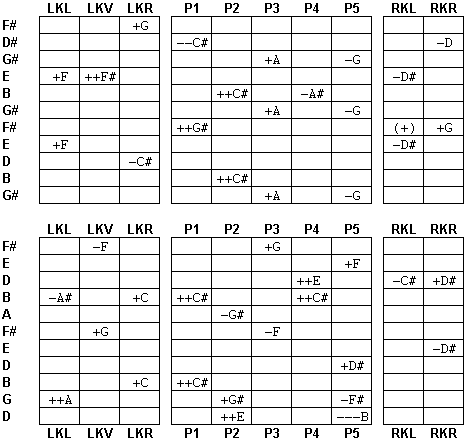Double 11 PSG?
Posted: 2 Mar 2004 10:18 am
The standard D-10 leaving the factory today is 8 and 4:
<font face="monospace" size="3"><pre>
A B C LKL LKR RKL RKR
F# G
D# D/C#
G# A
E F# F D#
B C# C#
G# A F#
F#
E F D#
D C#
B C#
4 5 6 7 8 RKL RKR
G G#
E F
C D B
A B B Bb
G F#
E Eb
C C#
A B
F F# E
C D A
</pre></font>
I been thinkun bout a guitar that would emulate just about all I have on my U-12 with 6 and 7; only zero in and specialize the B6/E9 tunings into two tunings.
I know, I know, it is supposed to be the other way around, but just for fun, I came up with the following setup that would allow me to play what I do on my U-12; If I had to go back to a double neck.
If that happened the following setup would be required.
Whatcha think?
First, it would HAVE to be a D-11 Setup this way:
<font face="monospace" size="3"><pre>
A B C 4 LKL LKL2 LKV LKR RKL RKL2 RKR
F# * G#
D# E D/C#
G# A G
E F# F D#
B C# C# A Bb
G# A G F#
F# * G#
E F D#
D C#
B C# A Bb
E F
</pre></font>
* slightly lower the F#'s when A is down.
(Note: RKL2 is setup so that when the 2nd string begins to pull, the F#'s are at a G note. This in affect combines two optional knee levers in use to day.)
<font face="monospace" size="3"><pre>
4 5 6 7 8 9 LKL LKL2 LKV LKR RKL RKR
D Eb
G G# **
E D F F
C D D B C#
A Bb B Ab
G F# F **
E D Eb F
C D C# C#
A Bb Ab
F F# E G
C D A
</pre></font>
** slightly lower the G's so the A7th chord is in tune since the A's and E's are cosiderably lower than ET.
(Note: There are splits on BOTH necks wherever it is applicable.)
Ya know what? It still does not get all the changes. I know I know, "ya only need 8 and 4". But me gots all dem changes now . So on second thought, I think I will stick to me U-12, since I am fat, dumb and happy now
. So on second thought, I think I will stick to me U-12, since I am fat, dumb and happy now 
God bless ya,
carl<FONT SIZE=1 COLOR="#8e236b"><p align=CENTER>[This message was edited by C Dixon on 02 March 2004 at 10:29 AM.]</p></FONT><FONT SIZE=1 COLOR="#8e236b"><p align=CENTER>[This message was edited by C Dixon on 02 March 2004 at 10:32 AM.]</p></FONT><FONT SIZE=1 COLOR="#8e236b"><p align=CENTER>[This message was edited by C Dixon on 02 March 2004 at 10:33 AM.]</p></FONT><FONT SIZE=1 COLOR="#8e236b"><p align=CENTER>[This message was edited by C Dixon on 02 March 2004 at 10:34 AM.]</p></FONT>
<font face="monospace" size="3"><pre>
A B C LKL LKR RKL RKR
F# G
D# D/C#
G# A
E F# F D#
B C# C#
G# A F#
F#
E F D#
D C#
B C#
4 5 6 7 8 RKL RKR
G G#
E F
C D B
A B B Bb
G F#
E Eb
C C#
A B
F F# E
C D A
</pre></font>
I been thinkun bout a guitar that would emulate just about all I have on my U-12 with 6 and 7; only zero in and specialize the B6/E9 tunings into two tunings.
I know, I know, it is supposed to be the other way around, but just for fun, I came up with the following setup that would allow me to play what I do on my U-12; If I had to go back to a double neck.
If that happened the following setup would be required.
Whatcha think?
First, it would HAVE to be a D-11 Setup this way:
<font face="monospace" size="3"><pre>
A B C 4 LKL LKL2 LKV LKR RKL RKL2 RKR
F# * G#
D# E D/C#
G# A G
E F# F D#
B C# C# A Bb
G# A G F#
F# * G#
E F D#
D C#
B C# A Bb
E F
</pre></font>
* slightly lower the F#'s when A is down.
(Note: RKL2 is setup so that when the 2nd string begins to pull, the F#'s are at a G note. This in affect combines two optional knee levers in use to day.)
<font face="monospace" size="3"><pre>
4 5 6 7 8 9 LKL LKL2 LKV LKR RKL RKR
D Eb
G G# **
E D F F
C D D B C#
A Bb B Ab
G F# F **
E D Eb F
C D C# C#
A Bb Ab
F F# E G
C D A
</pre></font>
** slightly lower the G's so the A7th chord is in tune since the A's and E's are cosiderably lower than ET.
(Note: There are splits on BOTH necks wherever it is applicable.)
Ya know what? It still does not get all the changes. I know I know, "ya only need 8 and 4". But me gots all dem changes now
 . So on second thought, I think I will stick to me U-12, since I am fat, dumb and happy now
. So on second thought, I think I will stick to me U-12, since I am fat, dumb and happy now 
God bless ya,
carl<FONT SIZE=1 COLOR="#8e236b"><p align=CENTER>[This message was edited by C Dixon on 02 March 2004 at 10:29 AM.]</p></FONT><FONT SIZE=1 COLOR="#8e236b"><p align=CENTER>[This message was edited by C Dixon on 02 March 2004 at 10:32 AM.]</p></FONT><FONT SIZE=1 COLOR="#8e236b"><p align=CENTER>[This message was edited by C Dixon on 02 March 2004 at 10:33 AM.]</p></FONT><FONT SIZE=1 COLOR="#8e236b"><p align=CENTER>[This message was edited by C Dixon on 02 March 2004 at 10:34 AM.]</p></FONT>


 </p>
</p>


